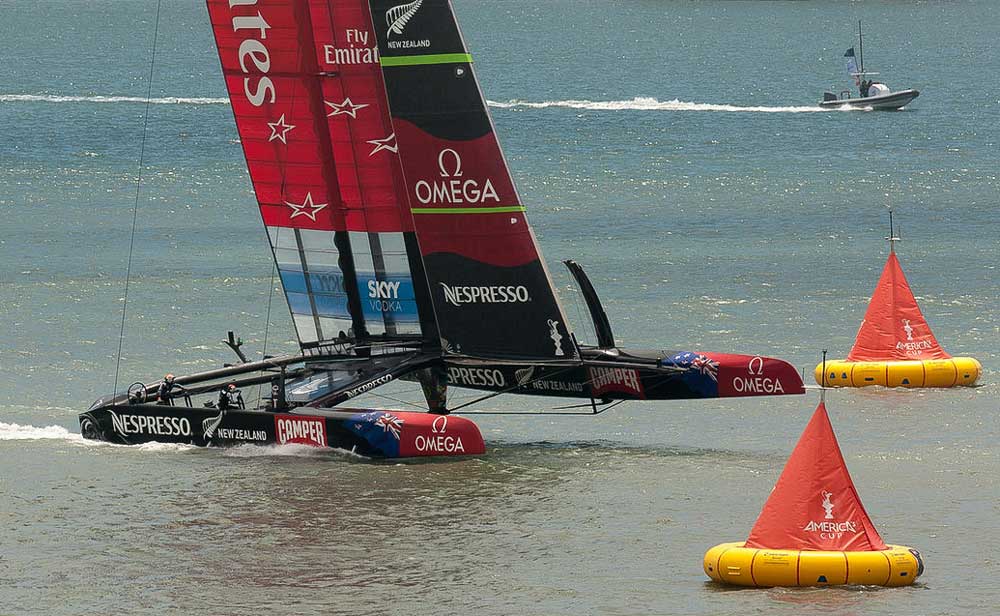
We’ve had one of those rare life altering moments, a point in time after which you know nothing will be the same. Having started messing with multi-hulls in the really olden days as we did, you might think the sight of a wing sailed cat crossing a finish line doing 20 knots upwind would get us stoked.
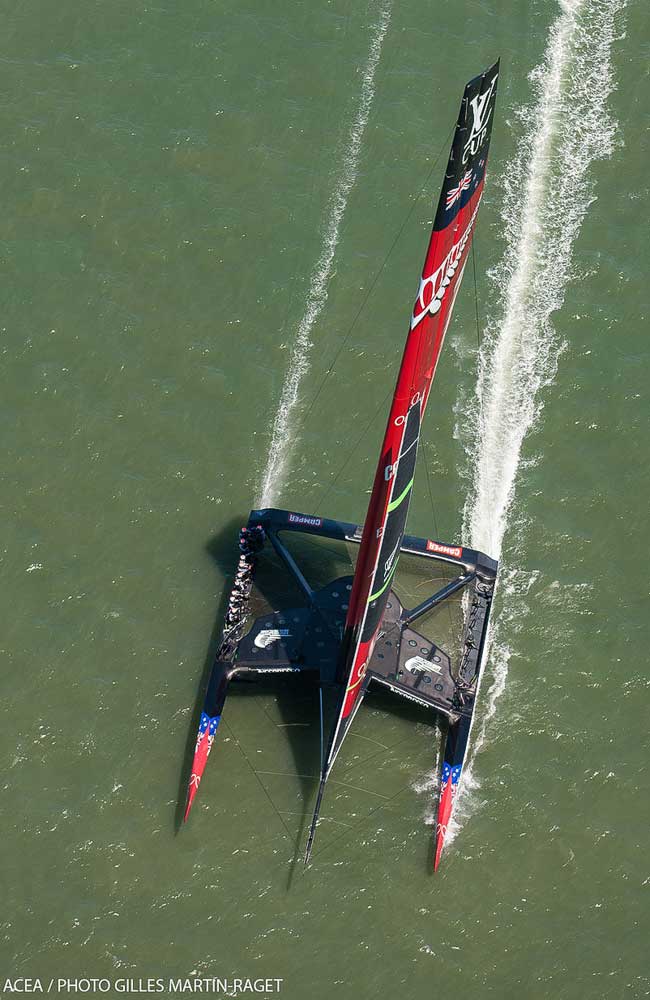
Or maybe this shot of an AC 72 beam reaching at an easy twice wind speed. But while our multi-hull CV is a long way from current, what we have shown you so far, while cool, fails to blow us away. Hey, we used to do twice wind speed–admittedly in optimum conditions–35+ years ago. And we had a (very) crude wing sail in 1969 and watched the C-Cat class develop these foils in the 1970s.

But this, gentle reader, is something else. Look closely at the leeward hull.
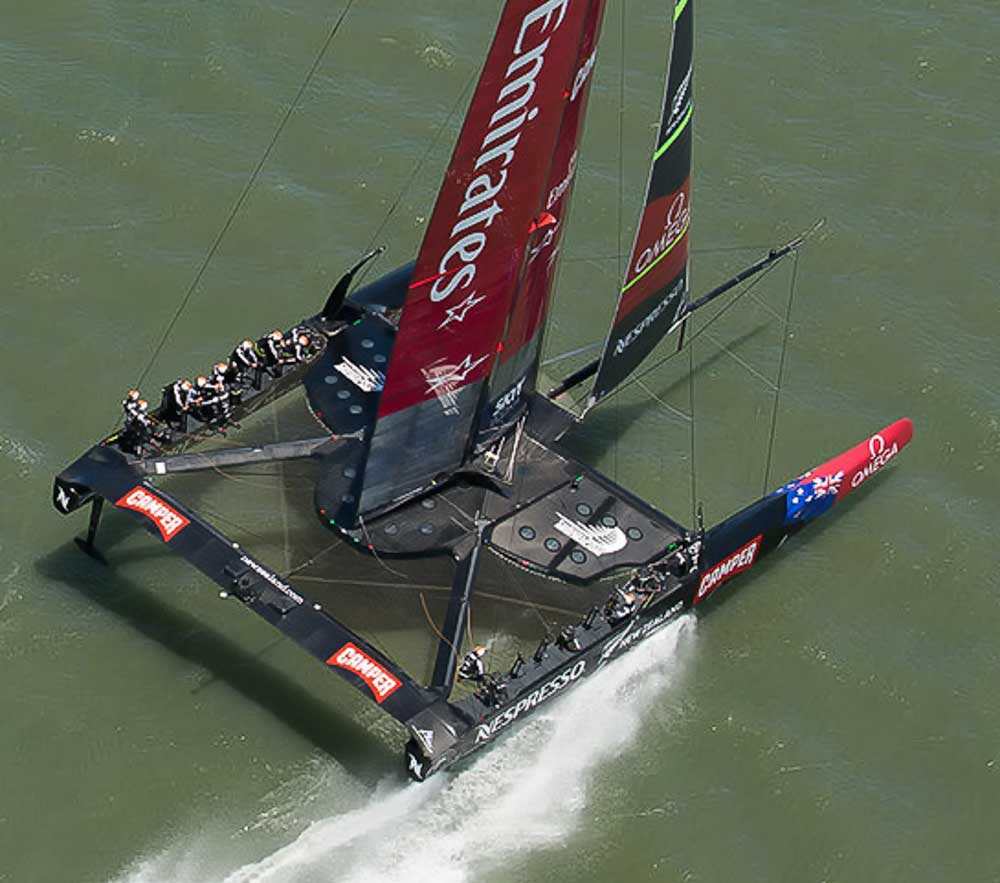
Look again.
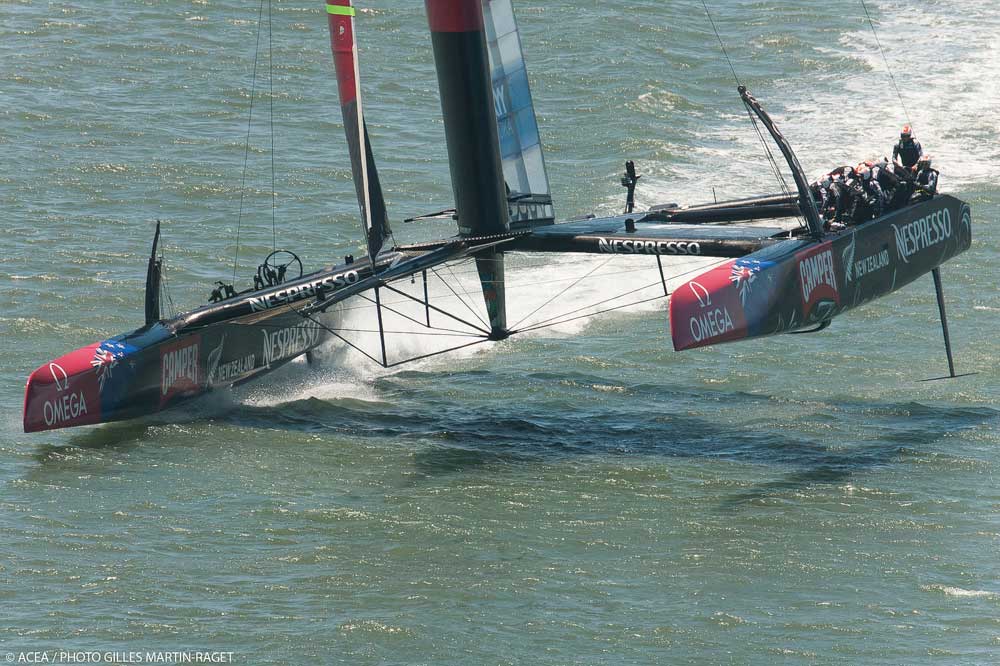
And again.
Have you been watching the first of the Louis Vuitton selection trials for the America’s Cup challenger on YouTube? Sure, the Kiwi challenger sails alone, the Italians protesting for some reason. But having just watched the most astonishing display of boat speed and sailing on the edge of disaster, making look easy what we are 100% certain represents the supreme achievement of man on water, we’d probably not want to be embarrassed by our relative incompetence either (if the Italians show up and make a race of it we’ll apologize).
If you have raced sailboats you will have at some point used the Vanderbilt time on distance race start method. The Kiwis do so as well, going from seven knots to 36 knots in seven seconds as they hit the starting line at full tilt.
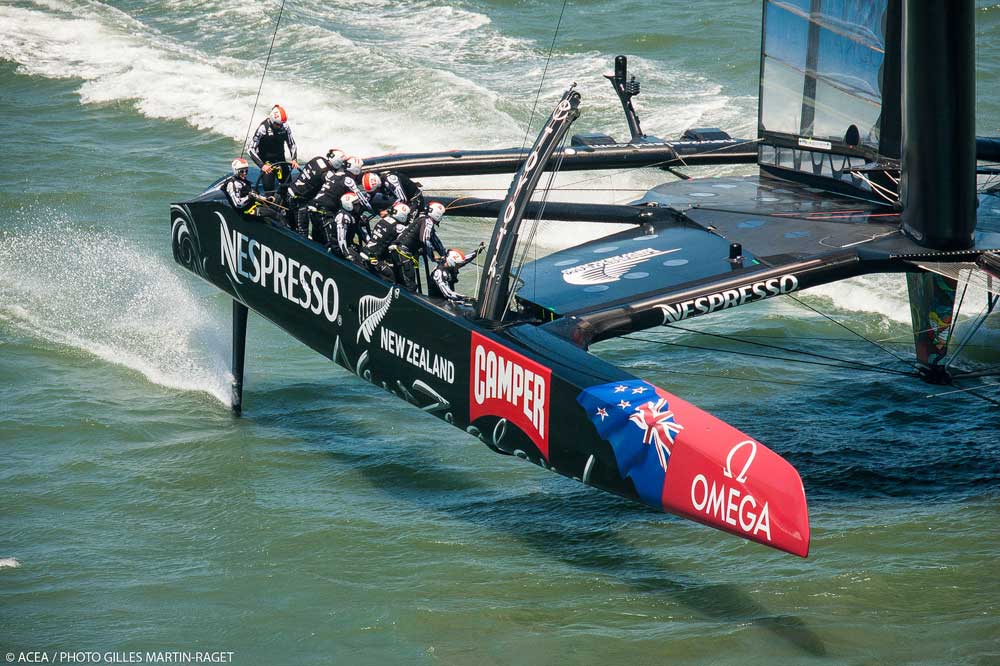
Flying momentarily? How about on all angles except beating, and our guess is that is not far off. Jibing and rounding marks while doing 30 to 35 knots or more, in less than 20 knots of breeze, still foil born? A piece of cake. Hitting 43.26 knots during this race, that’s 49.98 MPH! And they are probably not showing all their boat speed at this point.
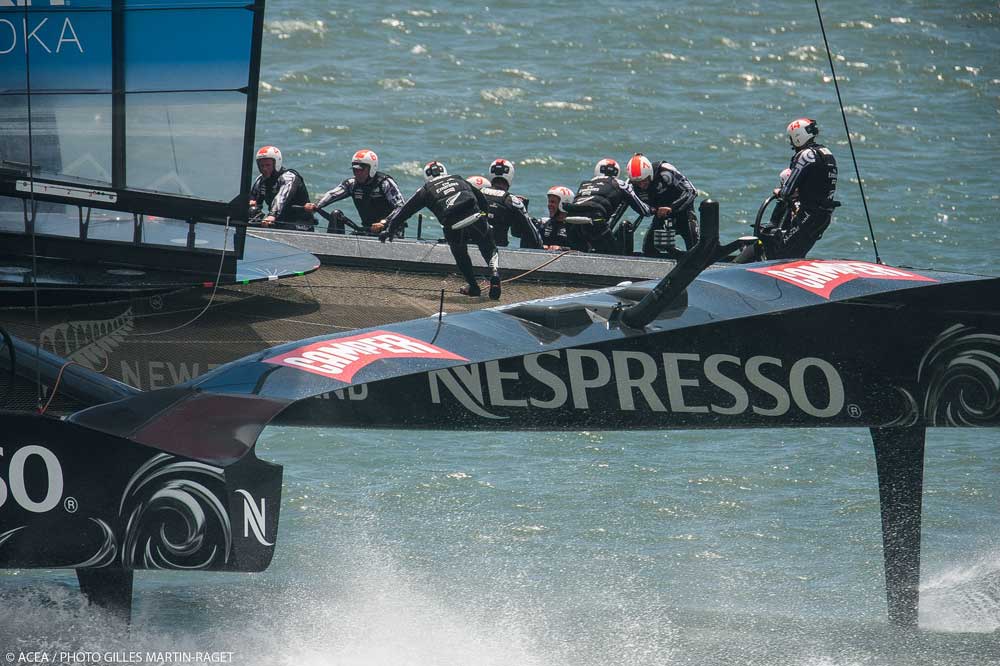
Sailing a multi-hull, wound up on apparent wind like Team New Zealand has been showing us, takes the highest degree of coordination between the driver, and the folks controlling the wing. As the boat accelerates keep in mind that the force of the wind builds with the square of the increase in wind speed. Small changes, up or down, have a huge impact on horsepower. Just driving off with the puffs, the way you would in a conventional cat or high performance dinghy, is not going to get the job done here. The wing trimmer, with his varying controls of the different wing elements, has to de-power in precisely the right manner.

Anything less than perfect coordination will lead to instant disaster.
Today’s race demonstrated a taste of what is coming. The camera work, tight shots to long views, was superb. The commentary most excellent.
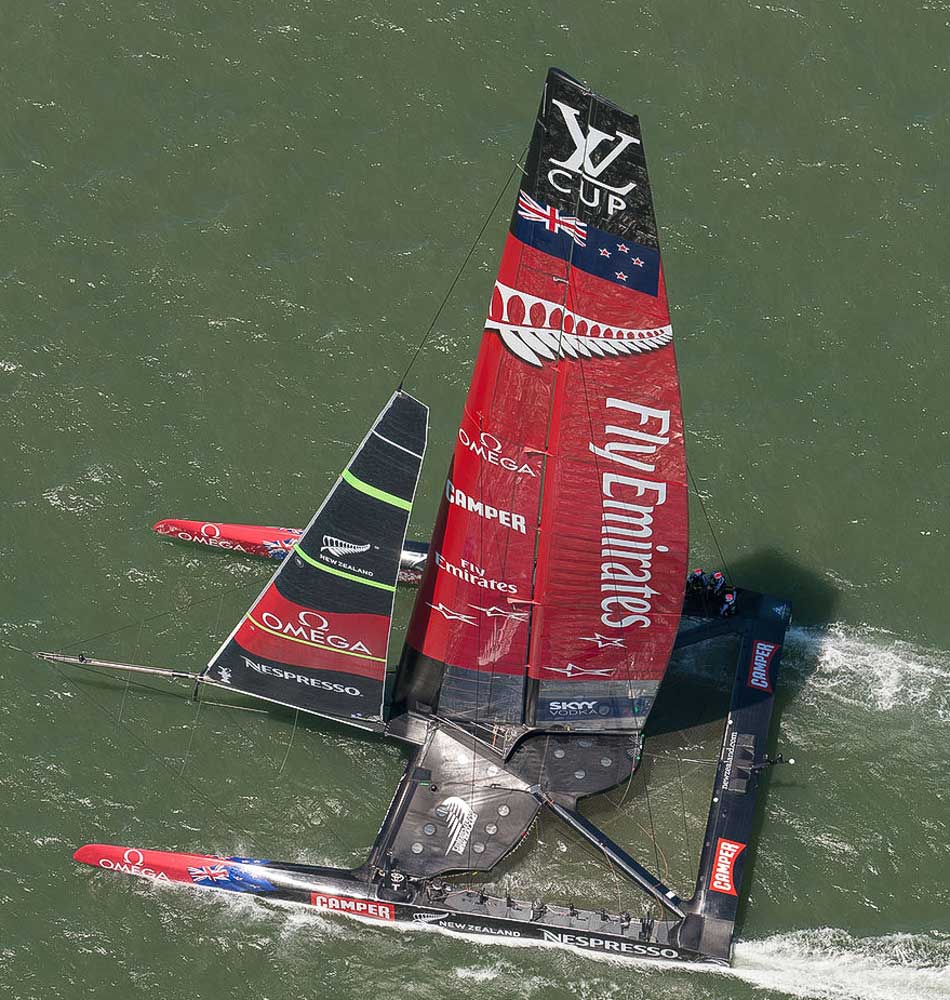
And the technical details – about which much more in later posts – simply astounding.
Our congratulations to Stan Honey for putting together an amazing presentation, the scope of which we’ll guess is yet to be displayed. To Grant Dalton, and the members of Team New Zealand, a hearty well done. If the cycle of the Cup were to end tomorrow, we’d say what we have seen made the effort worthwhile.
Russel Coutts and Larry Ellison have come in for a major helping of derision with the choice of high performance cats, and the lack of competition. To the naysayers we say, admit they were right. Even if there are only two competitive yachts racing in the end, this will have been the most amazing of sailing spectacles.
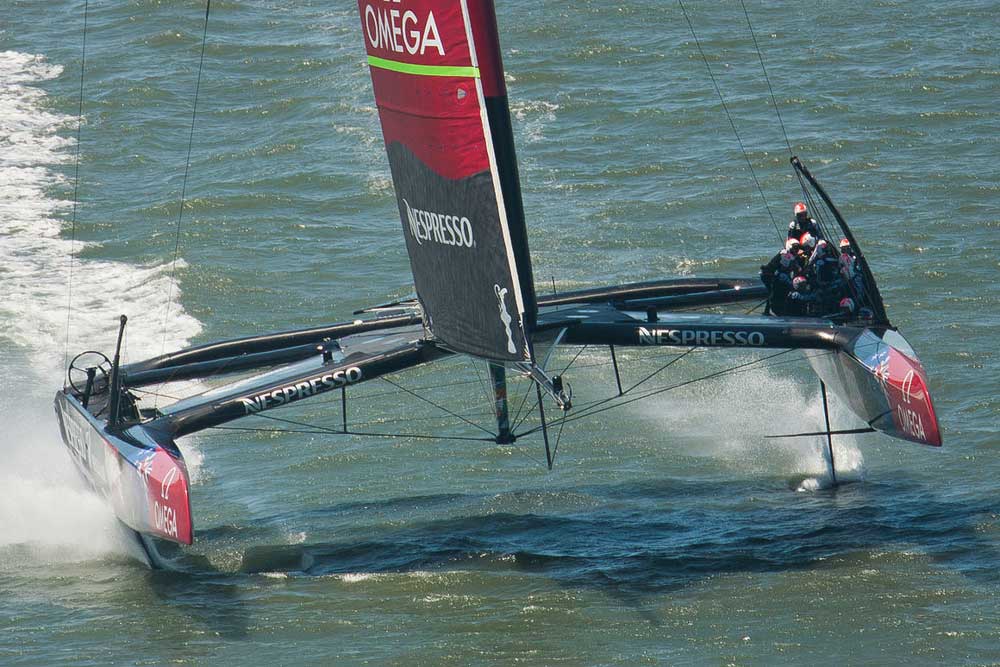
It suits us to a T. We think it will you as well.
Click here to watch the YouTube video to which we have been referring.

July 10th, 2013 at 11:21 am
So excited it’s in my home town! Will anyone from the SetSail team see it in person?
July 10th, 2013 at 11:53 am
There is a chance Kelly Archer will be there representing the New Zealand marine industry.
July 10th, 2013 at 7:11 pm
“Flying momentarily? How about on all angles except beating, jibing and rounding marks staying aloft, all the while doing 30 to 35 knots or more, in less than 20 knots of breeze”
Steve, did you see them recently. They can now do a full foiling jibe! Crazy. There must be some solid communication between helm, trim, and the guys who manage the boards, to pull that off.
Anthony
July 11th, 2013 at 1:06 am
Anthony:
Poor choice of words on my part. Meant to say the only time they were not foiling was going upwind. And I will bet that is not far off. When Curly Salthouse was asked about this (he is with TNZ) during commentary of the first race his answer sounded a little unsure, as in I cannot really say whether we can or not. We have no direct knowledge one way or the other, just that the rythm of his well oiled answers was momentarily broken. And, hey, if you can go upwind at 20 knots (!!!), then flying at the same time is just a matter of a little area one way or the other.
July 10th, 2013 at 7:34 pm
the tnz has no problems staying up on foils through a jibe – if you watch the second ‘race’ you see them do it several times
July 11th, 2013 at 1:02 am
Poorly written… meant to convey that they did stay aloft while jibing and rounding marks, and only did not foil while beating. Amazing!
July 10th, 2013 at 9:06 pm
I’m stoked too, Steve, and so glad to come across someone else who is positive about about AC34.
I watched the one boat race live on YouTube Sunday and am similarly awed by the boat technology and teamwork.
I’m very exciting about going to SF in early September to see at least a day of the finals as a guest of New Zealand, even if they’re not in the finals…which looks highly unlikely.
Best, Ben
PS I got behind the technology scenes of the AC World Series with Stan Honey & company in San Diego and wrote about it here:
http://www.yachtingmagazine.com/electronics/ac34-demands-your-attention
July 11th, 2013 at 6:19 am
Howdy Ben:
Wait until we see two of these cats dialing up pre-start, or better yet tacking down wind while jockeying for position…and foil born luffing matches at 30knots!
July 11th, 2013 at 7:35 am
I really hope we are going to see two beasts matching at last… Until now, even from tech point of view more than phantastic, as a regatta the AC is one giant disappointment. Concerning “simple” speed on the water I also love Vestas Sailrocket. Even smaller, way faster. An the moth (moth-sailing.org)as they are “for everyone”!!! I just saw 2 of them the other weekend. So fast…
July 22nd, 2013 at 3:15 pm
Steve do you foresee any application of the foils or foils of any type to FPB type yachts?
I know this is crystal ball type questioning… i recently saw in one of the yachting magazines one of the designers suggesting a foil or wing under the rear of the yacht to improve effiancy
July 22nd, 2013 at 5:45 pm
We have looked at hydrofoils going back into the 1960s and been unable to see a way they can work for cruising yachts. That said, the sight of the AC 72s foiling along at two or even three times wind speed is wonderful. If any of the SetSailors out there know of foils in use for crossing oceans we’d love to hear about it.
July 24th, 2013 at 11:46 am
Steve I found the article about using a foil on displacement yacht in the December 2012 issue of Yachting.
I could scan it and email it to you.
Thanks Paul
July 24th, 2013 at 8:16 pm
Love to see it.